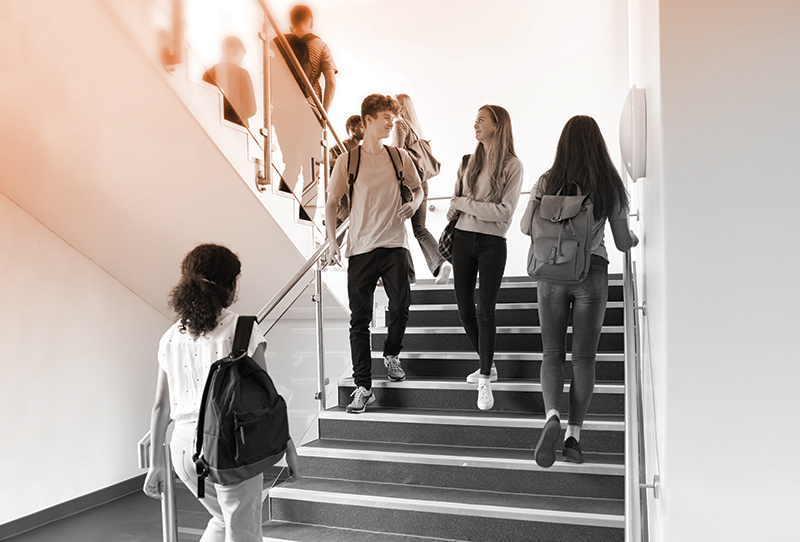Educators have been startled by the headlines …
“Ottawa student beaten senseless by peers in school washroom”
“15-year-old student shot and left for dead in Toronto high school parking lot”
“Cyber-bully harasses Port Coquitlam student to the point where she takes her own life”
“50 students brawl at Halifax high school”
“Kelowna parent pulls transgender child from the public school system:
Says school refused to address ongoing harassment and bullying”
Stories like these are front and centre in the minds of staff, students, and parents in what many are calling a new era of anxiety. Almost all jurisdictions are reporting a rise in incidents of harassment, bullying, and violence in schools, prompting stakeholders to ask:
‘Are our schools safe?’
The bad news
There is a lot of data that points to an uptick in negative behaviour in our post-pandemic schools. In a survey of teachers in Ontario, 80 percent of staff reported that violent incidents have increased in schools while 66 percent said the incidents were more severe than before the pandemic. In Manitoba, ‘biting, kicking, and verbal abuse’ have become so prevalent in provincial schools that the Workplace Safety and Health Department has declared education a ‘high risk industry,’ occupying the same category as foundries, sawmills, and demolition sites when it comes to safety. In British Columbia, a provincial report analyzing data gathered between 2011 and 2020 documented almost 17,000 ‘time loss claims’ filed by educators who were injured because of violent incidents in schools. Meanwhile, the Halifax Herald used a freedom of information application to gain access to data that revealed over 11,000 violent incidents occurring in area schools in the 2020-2021 school year (a time that included several weeks when students stayed home due to COVID shutdowns).
All this information paints a dire picture of the current state of safety in Canada’s schools. This is surprising to some degree given the concerted efforts of Canadian educators to create more safety in schools—a process that started over 20 years ago. Despite programs and policies that spell out the framework of what constitutes a safe school, staff and students are raising the safety alarm.
The good news
The good news is that educators are experts at creating safe and caring learning environments for their students. This starts with a holistic approach to the issue. When educators get into a conversation about school safety, they are usually looking at a range of topics that go beyond incidents of violence and capture issues like verbal and emotional abuse, bullying and other destructive behaviours. They also cover aspects of environmental safety dealing with building security and properly equipped classrooms. Overall, these conversations look at proactive ways to create a safe learning environment for all students.
So how is this done? Educators tend to look at the big picture by asking one fundamental question: what does a safe school community look like? A safe school allows for a free flow of learning with the absence of unnecessary and unacceptable distractions—like bullying, intimidation, violence or drugs. Relationships are respectful among the staff, between staff, students and parents, and within the student body. The school values academic and social achievement and has a rich co-curricular activity program. When things happen to disturb school harmony, steps are taken swiftly (bullies are confronted, graffiti is cleaned up, school resources are replenished). In other words, a safe school is one that recognizes, values, and holds a vision of what the ideal learning environment looks like from the moment a student walks through the door to the moment they walk out.
This might seem utopian. What school doesn’t have to deal with distractions, poor resources, and other things that make the learning situation less than ideal? After all, when you house hundreds of people in one building, there are bound to be many bumps as personalities collide and boundaries are pushed. However, it is establishing and striving for an ideal (utopia?) that is the true hallmark of creating safety in schools.
What role can the guidance counsellor play?
Guidance counsellors may not be able to make the big decisions leading to school safety changes, but they do have a voice when it comes to sharing their opinions. They can either do this by joining their school’s safe school committee (if the school has one) or employing some common-sense approaches to make the school a safer place. Often guidance counsellors are uniquely positioned to notice when things are amiss. This is frequently seen through concerns expressed about a student or disclosures from particular students. They may also notice things happening around the school that they aren’t comfortable with.
In the Guidance office
Guidance counsellors are on the front line of discerning threats to school safety. They might hear about a troubled student from a colleague or parent, or the student might reveal something troubling during a guidance appointment. When this happens guidance counsellors will work with support staff—mainly child youth workers and social workers—to put a safety plan in place for a student. This team approach—which always involves the parent or guardian of the student as well as the administration—does wonders for improving school safety. Recognizing and reacting to troubled students early on is the primary role a guidance counsellor plays in creating a safer school environment.
There are warning signs that emerge when a student is a potential danger to themselves and/or others. The American Psychological Association encourages guidance counsellors to be on the lookout for these patterns when it comes to students:
- Anger management issues.
- Disruptive in class.
- Involved in physical altercations.
- Threatens to hurt others.
- Lack of respect for the wellbeing of others.
- Defiance of authority.
- Drug use.
- Vandalism.
If students are involved in some or all of the behaviours listed, proactive intervention is necessary. A safe school is one that identifies and deals with trouble before it escalates. Meeting with the students, speaking with their teachers, contacting parents and guardians, and providing a clear message of what is and what is not acceptable is an important and necessary first step in keeping a school safe.
There are other student behaviours that might prompt guidance counsellor intervention. For example, students who isolate themselves—loners in the cafeteria or small groups that eat their lunch in a school bathroom—should be dealt with by a compassionate counsellor. A safe school has a strong co-curricular program. Maybe the loner student needs to be connected with a club or sport. Perhaps the students who are electing to avoid the cafeteria in favour of a washroom (gross!!!) can be offered the Guidance conference room or an empty classroom while they transition back to the cafeteria. Both situations are symptoms that demonstrate that students are not feeling safe. A safe school has a space and place for everyone. Guidance counsellors can help make this a reality.
Around the school
Administrators are often bogged down in a variety of issues that take them away from noticing things that need to be addressed around the school. Guidance counsellors can be that gentle voice that brings certain issues to their attention. For example, a strong administrator will know the things that make a school safe. Beyond acceptable and unacceptable behaviour, administrators should be aware of the physical elements of the school building that need fixing. For example, a leaky roof or chipped tile that needs repair. Lighting is also a huge issue. Students should be walking through bright corridors and learning in well-lit classrooms. Walls should be free of graffiti and painted regularly to create a fresh feel for the school community. Also, since many schools have surveillance cameras, administrators should be aware of ‘dead zones’—areas where students can hide from the cameras. If an administrator doesn’t seem to have noticed these areas of concern, a guidance counsellor may want to bring these issues to their attention. They would do this in the interests of creating a safe school for everyone.
Such suggestions may elicit this response: Hang on! That’s their job! Aren’t guidance counsellors supposed to stay in their lane! This is certainly true. However, if school safety is the driving force behind suggestions to the school administration, counsellors are not really doing an administrator’s job for them. They are simply saying, ‘What about this?’ and helping the administration avoid potentially prickly situations.
Expect people to do the right thing
Beyond expecting staff, parents, and students to behave in a civilized manner, there is also a need to make sure people do the right thing. From a common-sense perspective, when a violent incident occurs, a student is bullied, or someone destroys school property, there needs to a consequence. Often, when no consequence is presented, there is a tendency to sit back and blame someone—maybe the parents or, typically, the administration. This poses a number of problems for schools seeking to ensure safety. Firstly, no response or a poor response reinforces bad behaviour. Secondly, in our increasingly litigious society, the school’s response can rightly be held to a legislative standard. For example, many provinces have passed safe school legislation that mandates action on issues like violence and bullying. A failure to act can land staff in hot water with the school board or with the governing body of the profession in the province (like Ontario’s College of Teachers). Gone are the days where things can be swept under the carpet. Educators are being held to a high standard of conduct with policy and legislation in place if they fail to meet the standard.
Respect, discipline, compassion, civility, harmony, and unity
School safety doesn’t need to be a daunting task that requires a massive effort. It can be the issue that is handled in the classroom with an appropriate level of respect and discipline. It can be handled in the Guidance office with compassion and civility. And it can be dealt with by administrators who remember the dignity of each student while ensuring the school has the resources it needs to facilitate learning. In other words, a safe school insists on cohesion and will do everything in its power to make sure that harmony is the norm and unity is the perpetual goal.
By: Sean Dolan








